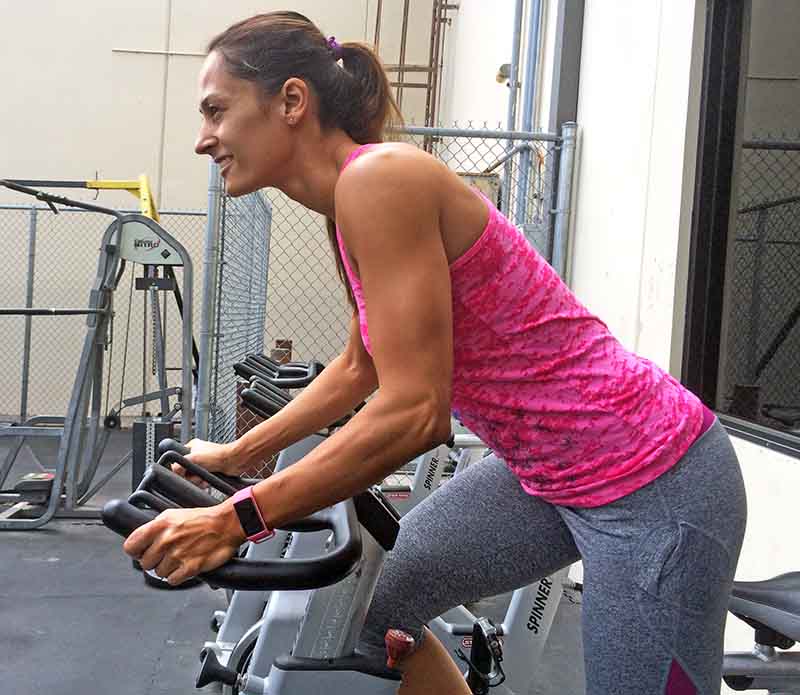Earlier than any kind of train or exercise, it’s possible you’ll have to do some psychological gymnastics to find out the correct amount of insulin and carbohydrates essential to gas your physique and forestall excessive or low blood sugars.
Let’s dive into how one can forestall low blood sugar throughout cardio exercises.
What to think about earlier than you begin exercising
The questions you’ll want to ask your self are:
- The place am I now?
- The place am I going?
In relation to pre-workout vitamin, you could possibly consider your physique as a automotive. If you’re solely going to drive across the block, you most likely don’t have to fill the gasoline tank. Nonetheless, for those who have been driving out of state, you definitely would wish to high off earlier than hitting the street.
Planning for the quantity of gas you want is step one. Additionally, you will want to think about the depth of the exercise. You most likely know that driving quick burns extra gas. The identical is true within the physique.
Individuals with insulin-dependent diabetes have a extra advanced system than this. Along with realizing how a lot gas you want, you need to additionally contemplate the quantity of carbohydrates in your physique relative to the insulin on board (the insulin remaining in your physique since your final bolus together with the present basal fee).
You should additionally reply this query: How a lot carbohydrate do I have to offset the present insulin on board?
To reply that query, you’ll decide 5 variables:
- Once you had your final bolus
- What number of items it was
- What number of correction items/ boluses have been taken
- The timing of corrections
- Present basal fee per hour (or complete long-acting insulin).
The quantity of carbohydrates is the variable an individual with diabetes must know to carry out properly. Carbohydrates present each vitality (gas within the tank) and an offset to insulin on board.
Proteins and fat should even be thought-about, though their contribution to elevating blood sugar is much less and slower.
Beneath, we are going to consider three timing choices previous to your exercise and talk about work out a pre-activity plan.
Three hours earlier than train
Taking your insulin three hours earlier than an exercise signifies that the insulin could have little impression in your blood sugar once you train. Most rapid-acting insulins solely have an effect on the physique for 3.5 to 4 hours. Nonetheless, what you do on this window will set you up for fulfillment in your exercise.
Three hours earlier than a exercise, you possibly can eat an everyday meal and take your regular bolus quantity. If you’re on an insulin pump, there’s normally no want to switch your basal fee at this level.
The quantity of carbohydrates to eat at this level is determined by your total day by day food regimen, however I like to recommend that you simply embrace a minimum of some carbohydrates with a ratio of round 80 % slow-burning (low-glycemic) carbohydrates to twenty % fast-acting (excessive glycemic) carbohydrates.
NOTE: In case your deliberate cardio exercise is of lengthy period or depth (like a half-marathon), you’ll most likely have to up your low-glycemic carbohydrate consumption at this level to make sure that you have got the required vitality to carry out.
3 hours earlier than train suggestion abstract
- Bolus usually
- Eat a meal with an 80/20 sluggish/quick burning carbohydrate ratio
- Maintain baseline basal charges working usually

One hour earlier than train
The hour earlier than train is a crucial interval. If you’re hungry and have to bolus, it will have a considerable impression in your blood sugar.
Many insulins peak between 50 and 90 minutes. They are going to stay energetic throughout your complete exercise and doubtlessly longer than your exercise interval.
Consuming carbohydrates throughout this window can have a optimistic affect on train efficiency, however doubtlessly a unfavourable impression on blood sugar administration.
In case you resolve to eat some carbohydrates, you might be left with the query of what to do together with your insulin. There are three good choices, and so they all depend upon the insulin on board and the carbohydrates wanted to carry out.
Right here is the place you’ll want to be a forecaster somewhat than a fortuneteller. It’s the “Know Earlier than You Go” plan. The three choices are:
- Eat no carbohydrates. Don’t take a bolus.
- Eat wholesome fat and/or lean proteins. Don’t take a bolus or corrections.
- Eat carbohydrates. Take into account bolusing.
1. Eat no carbohydrates. Don’t take a bolus.
That is the only of the three choices. It doesn’t require any explicit change to the routine till proper earlier than your exercise. Your major consideration shall be to watch excessive blood sugar.
In case your blood sugars are excessive, I like to recommend you make any corrections at 40% of the steered pump correction issue. I’ve additionally had good outcomes with turning off the pump basal instantly earlier than exercising to forestall low blood sugar.
2. Eat wholesome fat or lean proteins. Don’t take a bolus or corrections.
One other easy choice is to eat wholesome fat and/or lean proteins within the 60-minute window earlier than train. This additionally doesn’t require any change to the routine till you’re about to start out your exercise. You don’t should take a bolus or make any corrections to your pump.
Maintaining a healthy diet fat and proteins throughout this era will assist satiate you and maintain your vitality degree up with out spiking your blood sugar. Any insulin on board won’t adversely have an effect on your exercise after maintaining a healthy diet fat and proteins. Each macronutrients soak up extra slowly, so they supply glorious long-lasting vitality.
Examples of those meals are seeds, avocados, and egg whites. You can find that this feature is nice in its simplicity and talent to gas exercises!
3. Eat carbohydrates. Take bolus.
If it’s important to eat carbohydrates this near figuring out, then eat not more than 100 energy value. That’s about 20 grams of carbohydrates.
You shouldn’t eat any greater than 20 grams of carbohydrates as a result of the insulin you’re taking throughout this era will trigger a dramatic discount of blood sugar throughout train. It would additionally require you to eat extra carbohydrates throughout train. The much less insulin you’re taking earlier than train, the much less you’ll have to eat throughout an exercise.
It’s additionally a good suggestion to eat slower-burning, low-glycemic carbohydrates throughout this era. Consuming fast-burning, high-glycemic carbohydrates will spike your blood sugar too quick, making you go excessive at the beginning of your exercise.
The important thing to this feature is the dimensions of the bolus you’re taking to offset the carbohydrates. You need to be simple with the bolus and presumably not even take one.
Any corrections made on this time window must be half the traditional correction quantity to keep away from a major impression on blood sugar throughout train.
Usually when somebody takes a full correction this near exercising, they are going to slip into low blood sugar inside the first 20 to half-hour of train. The end result might be extremely irritating once you’re making an attempt to give attention to an essential apply or get in a brief quantity of exercise. Smaller corrections will deliver your blood sugar down slower, so long as you start train quickly afterward.

Know earlier than you go
The important thing to peak efficiency and managing this crucial interval is planning.
Know when you can be energetic and plan your food regimen (and consequently insulin wants) properly prematurely. If you understand you’ll be energetic in the course of the day, attempt to eat a bigger portion of carbohydrates properly prematurely of your meant train. This won’t solely offer you sufficient to take the right bolus and correction, however it’ll additionally offer you loads of time to course of sufficient carbohydrates to carry out at your greatest.
This technique is much like the biking idea of separating braking and swerving to soundly lean by a flip. Hammering the brakes in the course of a flip will increase the chance of crashing. Taking a bolus simply earlier than train is like braking in the course of a flip. Following these tips will enable you separate the braking from the swerving and get you thru your exercise safely.
half-hour previous to train
This time window requires comparable issues because the one hour earlier than train window. The main distinction is fine-tuning your basal (in case you are a pumper) relying on whether or not you have got barely excessive or low blood sugar.
As an illustration, blood sugar between 180 and 200 mg/dl (10 and 11 mmol/l) might be managed with a brief basal fee adjustment enhance of 20 % from baseline for half-hour as a substitute of taking a correction bolus. The little bit of additional insulin will assist to decrease a barely elevated blood sugar as soon as you start exercising.
In case your blood sugar is greater than 200 mg/dl (11 mmol/l) it will be higher to do half the traditional bolus correction.
Deciding to not eat on this window might additionally impression your blood sugar. In case you don’t eat and you’ve got barely low blood sugar, it is best to scale back your basal fee between 10% and 50% from baseline.
If you’re not utilizing a pump and are on injection remedy, it’s possible you’ll decide to eat a small quantity of carbohydrates in case your blood sugar is decrease than 115 mg/dl (6.4 mmol/l).
Conclusion
A lot of what I’ve been describing on this publish is a proactive strategy to meals and insulin administration. Take into account that life usually will get in the way in which of the peerlessly arrange exercise and routine! Be versatile and all the time carry further glucose.
The important thing takeaway is to keep in mind that the adjustment of complete insulin on board and carbohydrates is what’s going to set you up for fulfillment in relation to cardio. Training these ideas does take expertise, and it’ll take time to hone in in your routine.










